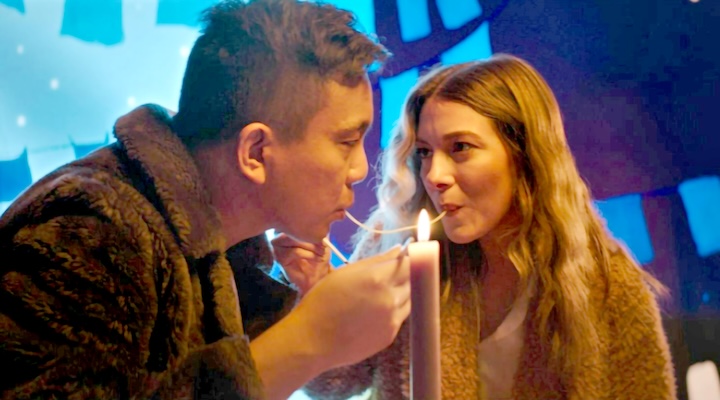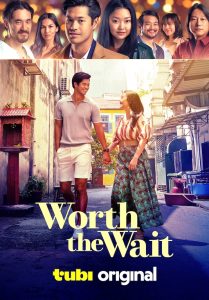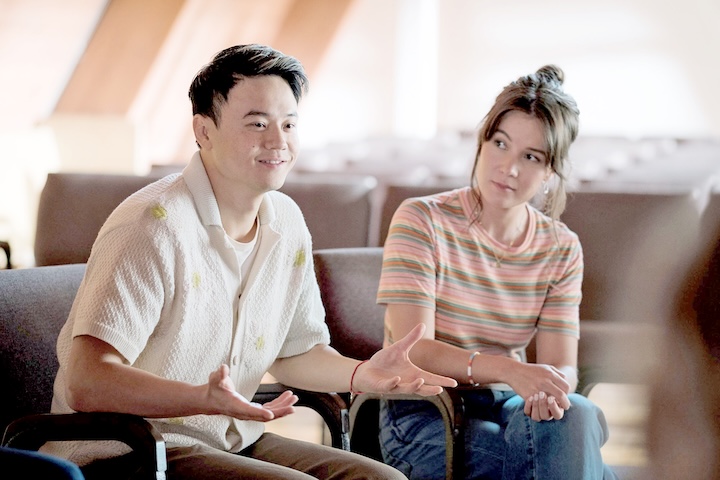‘Worth the Wait’ and ‘Meet Cute in Manhattan’
give Asian American flavor on a beloved genre.
By Paul Goodman, P.C. Contributor
In the rom-com, a genre built for audiences to escape and meet cute, fall in love and get swept away in a larger-than-life, whirlwind romance, there are always some who identify more with the supporting cast than the main characters.

Terrence Chen and Kendall Leary re-create a scene from “Lady and the Tramp” in “Meet Cute in Manhattan.”
In classic Western rom-coms like last-century’s “You’ve Got Mail” (1998) and “When Harry Met Sally” (1989), as well as more recent takes such as 2011’s “Crazy, Stupid, Love.” or 2012’s “Silver Linings Playbook,” the main cast, and the perspectives of the main characters, represent what the film industry believes are the acceptable love stories that audiences will pay to see.
Usually, that identifies with one shared, homogenous and common characteristic, a visual pallet so bland you rarely have to ask the waiter how to pronounce it. That was until 2018, when one movie delivered the umami for which many had been so desperately searching. Budgeted at $30 million, the latest tally for “Crazy Rich Asians” has it at a worldwide box-office gross of just under $175 million, surely one of the more profitable recent rom-coms made.
That success opened the doors for new stories, new protagonists, new flavors in the vanilla scoop that was the American romantic-comedy culinary landscape. Over the seven years after “CRA’s” release, we’ve had storied hits like “To All the Boys I’ve Loved Before” (2018), “Always Be My Maybe” (2019) and “Beef” (2023), which cast Asian Americans in lead roles, facing traditional first-world problems common to all, like exploring high school crushes or dealing with road rage.
In other words, studios realized that they’ve been serving the same Kraft Velveeta on Wonder Bread toast to audiences hungry for cultural significance, ideas and people that cater to a 21st-century American demography.
This spring, timed to celebrate AANHPI Heritage Month, two films — “Worth the Wait” and “Meet Cute in Manhattan,” both of which can be viewed on Tubi and other streaming services — stepped up to continue the path first forged by “Crazy Rich Asians” and deliver Asian American faces and voices in roles that audiences had in the past been denied.
Seattle was the backdrop for one of the most iconic rom-coms in cinema history, “Sleepless in Seattle,” which included iconic landmarks such as Pike’s Place, Alki Beach and Lake Union, venues that, upon viewing that movie, you wouldn’t believe are located in a city where almost 20 percent of its residents identify as Asian or Asian American.
 That’s not an issue in Tubi Original’s “Worth the Wait,” which follows the arcs of three different relationships that all intersect in different ways throughout. Yes, the entire starring cast is Asian-identifying, but this movie doesn’t wave a flag throughout, pronouncing any heroism for merely casting with the same broad strokes as its counterpart Seattle narrative “Sleepless.”
That’s not an issue in Tubi Original’s “Worth the Wait,” which follows the arcs of three different relationships that all intersect in different ways throughout. Yes, the entire starring cast is Asian-identifying, but this movie doesn’t wave a flag throughout, pronouncing any heroism for merely casting with the same broad strokes as its counterpart Seattle narrative “Sleepless.”
“Worth the Wait” instead gives us the meet cutes and dorky falls, the quippy lines and flirty smiles of a real American love story. There’s rom and there’s com, and the film’s Asian-ness is only a distracting point to those who can’t believe these six people could fall in love.
It took “Crazy Rich Asians,” blatantly warning viewers in the title, that they were about to watch a film about (gasp) Asian people, to invent a media space where Asian stories can be about everyday things. Pregnancy, young love, distance, hardship, fear and trauma don’t need an Asian suffix to be a movie about Asian people.
Just like no one needed to identify Tom Hanks and Meg Ryan to authenticate their love stories, “Worth the Wait” does us the respect of presenting love stories we can relate to without having to hold audiences’ hands and explain the latter half of Asian American.
For one of the distaff cast members of the three couples, Ali Fumiko Whitney (Riley), who also served as an executive producer, “Worth the Wait” was a project that represented that perspective. “I’m very passionate about being a part of projects that tell these stories and cast Asian talent,” she told the Pacific Citizen. “That was a big reason why I wanted to help EP this film and hopefully many more films with more Asian stories and Asian actors and directors and writers.”

Ricky He and Ali Fumiko Whitney co-star in the ensemble Asian American cast of “Worth the Wait.
While giving the platform for a modern love story, “Worth the Wait” also speaks to the generational journey of many Asian Americans. Poignant questions for many people in the community, “What generation are you?” and “How far away are you from your immigrant ancestors?” in this film that follows many different central characters and narratives, the main protagonists might all have different answers.
Curtis, played by “The Fast and the Furious” franchise fave Sung Kang, is a rideshare driver and may say first or second generation. Same with Mary, played by Kheng Hua Tan, the mother and stepmother of a couple hoping to get pregnant. There are later generation characters like Leah, played by Lana Condor and hapa Asian Americans, as well as expats and international stories.
“Worth the Wait” puts on full display a complex tapestry of Asian American experiences and interweaves these characters through their relationships. There isn’t one type of Asian, just like there isn’t one type of love story. Romantic love, platonic love, familial love all mirror the identity and history of a vast migration of peoples, a fictional community that came to be in the very real neighborhoods of Seattle.
Another icon of rom-com city backdrops is undoubtedly New York City. Whether a chance encounter in a coffee shop or a fated meeting atop the Empire State Building, New York, and especially Manhattan, is the one of the focal points for fictional love in the known universe. “Meet Cute in Manhattan” is the other new Asian American rom-com that pays homage to the city and the genre but also manages to also subvert it in its own way.
 Writer, executive producer and lead actor Terence Chen appears in a New York coffee shop wearing a Jeremy Lin jersey when love interest Nora (Kendall Leary) spills a drink on him. That’s where these characters meet, and, like so many other meet cutes in film history, that’s where their relationship begins. Contradicting stereotypes but reinforcing the standard boy-meets-girl trope is that Chen’s character, Jason, is forward and asks her out. Not only does he ask her out, but he has charm and charisma. She is attracted to him.
Writer, executive producer and lead actor Terence Chen appears in a New York coffee shop wearing a Jeremy Lin jersey when love interest Nora (Kendall Leary) spills a drink on him. That’s where these characters meet, and, like so many other meet cutes in film history, that’s where their relationship begins. Contradicting stereotypes but reinforcing the standard boy-meets-girl trope is that Chen’s character, Jason, is forward and asks her out. Not only does he ask her out, but he has charm and charisma. She is attracted to him.
It is refreshing to see Jason as an object of desire, an Asian male lead amid Hollywood’s history of emasculating typecasting and neutered side characters, especially from Nora, who fits a classic American appeal, only further validating Jason’s machismo for those that might be more comfortable with romantic segregation.
Both “Meet Cute in Manhattan” and “Worth the Wait” identify with Asian heritage while delivering a latter-day American romance. Being Asian American is at the core of both these stories, but from the choir’s perspective, they are never preaching.
In a post-“CRA” world, the release of these films comes in an era of storytelling where we don’t have to justify why we are here. Like the generations before us that often sacrificed everything for a better future, these films can represent the lives they built. Characters, not totally free from discrimination, are free to love and have crushes, be artists, live good lives, marry whoever they chose.
A rom-com is the ultimate idealism, a cinematic escape where you are witty, beautiful and loved. For so long, that space was strictly reserved for the usual suspects. But with each generation, the feast grows, and audiences have shown that a rotating table is just as good as a square one.
This article was made possible by the Harry K. Honda Memorial Journalism Fund, which was established by JACL Redress Strategist Grant Ujifusa.



